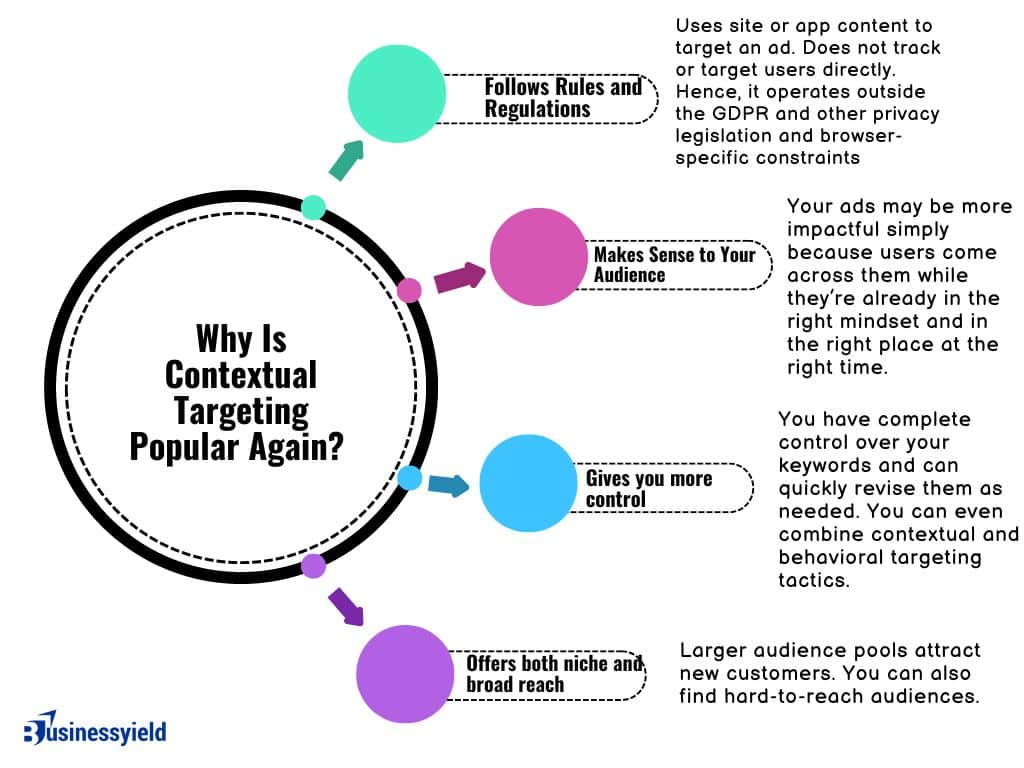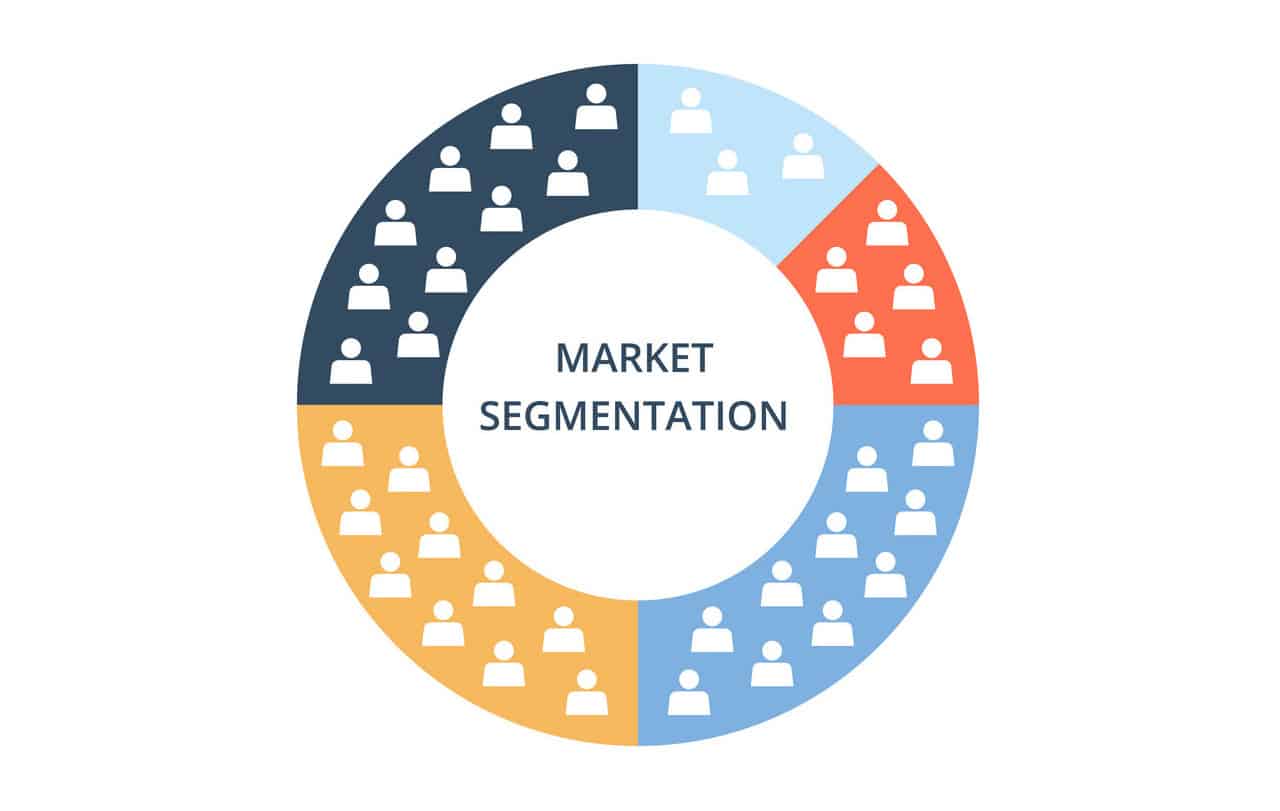As a business owner, your ultimate goal is to have your marketing efforts reach your target audience, the people who are most likely to be interested in your products and services. While there are several ways to do this, contextual targeting more than gets the job done while being cost-effective to boot.
Running paid ads — like pay-per-click (PPC) on Google — feels like you’re spending a lot of money without seeing any results. And with 70% of consumers seeing irrelevant ads from brands at least once a month, it’s no wonder so many are put off by online ads.
Contextual targeting solves that problem.
Key Points
- Contextual targeting allows your ads to show up on web pages that have content that’s closely related to your products or services.
- There are several sub-categories of context targeting, including contextual keyword targeting, keyword contextual targeting, and semantic targeting.
- Contextual targeting works by choosing a topic/keyword parameter for contextual targeting, after which Google analyzes the page and then places the ad.
- With contextual targeting, your business can use different ad formats.
What is contextual targeting?
Contextual targeting is a form of personalized advertising that enables your Google PPC ads to appear on relevant sites. It allows your ads to show up on web pages that have content that’s closely related to your products or services.
For example, I have a friend who runs a fitness lifestyle company. In this case, he uses contextual targeting to place fitness ads on web pages that discuss workout routines or sell activewear.
There are several sub-categories of context targeting, including:
- Contextual keyword targeting: Ads are targeted to websites, pages, and apps that match specific keywords.
- Keyword contextual targeting: With keyword contextual targeting, your ads are placed on web pages based on the target keywords that you specify. This type of contextual targeting provides you with more flexibility—and potentially more accuracy—when placing ads.
- Semantic targeting: A more advanced type of contextual targeting that uses AI to understand the actual meaning of a page or app, as opposed to just directly matching keywords on the page.
Marketers can also target more manually by advertising in publications that focus on specific topics that are related or relevant to the apps or products they are advertising.
SEE: Effective Online Advertising Strategies For 2024 With Real-Life Examples
Here is how contextual targeting is used:
After a website has been crawled or the context of the website or app has been determined, this data is then sent to ad networks, which in turn can be used by advertisers for contextual targeting.
As Google highlights, this is how the process of matching ads to relevant sites works:
Google’s system analyzes the content of each webpage to determine its central theme, which is then matched to your ad using your keywords or topic selections, your language and location targeting, a visitor’s recent browsing history, and other factors.
To get started, input keywords or topics, and set your campaign to show ads on the Display Network. Google will then analyze the content on a website and match that against your ad using keywords, topics, language, and location.
By setting up your ad targeting, contextual ads will use keywords, topics, location, and so on as opposed to individual user behaviors or interests.
What is contextual traffic?
Imagine scrolling through a website that gives you information about car parts and accessories and getting hit with a dynamic ad for some latest car accessories in the market.
The idea is to target the ad at a section of people who are more likely to hit the “buy” tab. This is where the relevance of the term “contextual traffic” comes in.
Contextual traffic is also referred to as a pay-per-view (PPV) form of advertising. Since only the relevant ads are put on a particular website, advertisers are required to pay per view of the ad (irrespective of the user clicking on it).
READ: CLICK FUNNEL: What Is It, How to Create It & Review
Types of contextual targeting
With contextual targeting, your business can use a few ad formats, including:
- Video: A video ad, like one on YouTube, can target user interests by what they’re watching. If someone clicks on a video about waxing cars, for instance, they may receive an ad for car wax on that page or video.
- Native: A native ad can feature contextual targeting. In appearance, native ads look like they’re a natural part of a website. They align with the visual design of a site, for example, which can make them more enticing and trustworthy to users.
- Behavioral: A behavioral ad combines the context of a page with a user’s behavior, like their location or pages visited. For many businesses, behavior, and context offer a powerful approach to online advertising.
The ad in the video above might sound a little confusing, but only if you don’t know what to look for. In less than a minute, Ryan Reynolds has managed to market his movie 6 Underground, a Samsung QLED TV, his brand of gin (Aviation Gin), and then himself as both an actor and an advertiser, all the while maintaining self-awareness and humor.
A simple breakdown of it goes thus: if you like action movies, you will definitely want to see it on a bigger screen, and why not enjoy the movie while sipping some gin? And you’re probably a fan of Reynold’s if you enjoy action movies. This is an ad within an ad within an ad within an ad.
The Golden Unicorn of contextual targeting.
How contextual targeting works
In contextual targeting, the user’s interest and intent are assessed by leveraging information about session data. This is in contrast to behavioral targeting in which cookies are used to recreate a user’s browsing behavior.
Generally, the process works as follows:
1. Choose topic/keyword parameters for contextual targeting
An advertising system needs to know what your campaign is about to place your ads on relevant web pages. In keyword and topic-based contextual advertising, the ad publisher relies either on the primary keyword associated with the web page or its topic.
- Topics. Topics are broad categories under which your campaign may fit, such as fashion, travel, and leisure. By choosing a category, your ad will be qualified to appear on relevant websites throughout the Google Display Network. Categories might start broad, like “Auto,” and then narrow down to subcategories like “SUVs and Trucks,” or “Motorcycles”.
- Keywords. Keywords are precise subtopics and search terms that relate to your specific product or service like “trail running shoes” or “travel yoga mats”. If you sell travel accessories, you might include keywords like, “travel bags for women” or “travel toiletry bag”.
In short, if the keywords or topics you’ve chosen match the central theme of a website, your ad is eligible to show up on that site.
SEE: SEO Keywords: Simplified Guide On How To Do Keyword Research (+ Free Keyword Research Template)
Relevant ads can be displayed in the form of banners, carousels, and more. Keep in mind that this requires manual judgment and execution on the part of the publisher. They need to ensure the ads they’re displaying align with the interests of the target audience. Topics generally include a broader category that fits your ad campaign.
For example, in fashion, sports, vehicles, etc., you can run your ads based on these categories using Google Display Network (GDN). They also give you the option to be more precise by selecting sub-topics or sub-categories. Advertisers can select women’s fashion, and then go on to pick from several sub-categories like bags, footwear, tops, and more.
2. Google analyzes the pages in its network
Once you place your order, Google will try to match your ad with the most relevant content. It takes into account text, language, page structure, link structure, and your keywords—in addition to other targeting. When using the GDN, you can set your network settings to either broad or specific reach. With broad reach, your ad will be based on topic targeting.
With specific reach, your ads will appear only on pages that match keywords and at least one of your targeted topics.
3. Your ad is placed
After the above analysis is complete, the display network finds a placement that matches your ad contextually.
How to implement contextual targeting
Contextual targeting allows you to reach your target audience in relevant and meaningful contexts, increasing the effectiveness of your advertising campaigns and maximizing ROI. However, it’s essential to balance targeting precision with user privacy and data protection concerns to maintain trust and compliance with regulations.
Implementing contextual targeting in your advertising strategy involves several steps to ensure effectiveness and relevance. Here’s a comprehensive guide on how to implement contextual targeting:
Implementing contextual targeting
Benefits of contextual targeting
If you’re thinking about using contextual targeting in your advertising strategy, you want to make sure it’s a smart investment for your business. Using contextual targeting, however, offers several competitive advantages when it comes to online ad campaigns.
Contextual ads take targeting to a whole new level
Targeting is one of the most significant advantages of contextual ads.
SEE: Why Narrow Targeting Is Essential to Your Ad Campaigns
With contextual advertising, your business can create ads tailored to a user, from their interests to their online behavior. Whether you’re looking to reach a niche audience or a broad one, contextual targeting can help you reach the right people at the right time.
For example, if your business uses contextual targeting in Google Ads, you can refine users by:
- Demographics
- Topics
- Interests
- Keywords
- And more
All these different filters allow your company to create a targeted audience for various ad groups.
Privacy-oriented advertising
There are brands where target audiences are quite aware of their privacy and don’t want websites or advertisers collecting their personal data. Moreover, there has long been a debate about the ethics of collecting user data, especially when it’s done so without permission.
Technology-oriented brands such as consumer electronics blogs and cryptocurrency exchanges have target audiences that are privacy-aware and often don’t allow these services to install cookies on their devices which can be used to track their internet activity.
In terms of privacy concerns, contextual advertising can be used by a brand or ad publisher, so they can still earn revenue while complying with these issues.
SEE: Revenue vs Sales: A Comprehensive Guide to Distinguishing Revenue From Sales
Contextual ads get users engaged and excited
People want a personalized, targeted experience. That’s why 90% of leading marketers credit personalization for contributing to their company’s profitability. It’s also why seven in 10 consumers want and prefer personalized ads.
With contextual targeting, your company can deliver on user expectations, plus reap the financial benefits. When you engage users with ads personalized to their interests, you can get them excited. That isn’t easy, and it’s a massive accomplishment.
Engaging and exciting users can directly impact your click-through rate (CTR), as well as conversions. If you can do that with your advertisements, why not do it?

Contextual ads generate real results
You want results, and so do your company leaders. Whether it’s more clicks, leads, or sales, you have benchmarks that you need to reach.
SEE: What are Outbound Leads and Do You Need Them?
Contextual advertising can help your team accomplish those goals. That’s because you’re taking a user-focused approach to advertising that goes beyond bids, ad copy, or landing page design. Like search engine optimization (SEO), contextual targeting allows you to connect with users at the perfect moment.
That’s because SEO helps improve your visibility in search results, as well as revolves around the use of search engines. If someone searches, “sweet smelling candles,” on Google, they’ll receive a list of relevant search results, like a compilation of e-commerce sites or a write-up of the best candles by a blog. Similarly, with contextual advertising, people receive ads tailored to their current interests and browsing history.
Essentially, these pages prime users for your ad, making them more likely to click on it. For your business, this priming can result in significant changes in ad performance. You may see an increase in clicks and conversions, as well as improvements when it comes to how long users stay on your website.
Easier to manage brand reputation
One of the major risks of depending on user behavior to display ads is exposing the website to display a wide variety of ads from any industry.
Ad publishers can exercise some control over this by excluding adult and violent categories but still a few ads can sneak in and show up on the website. It means that a brand has limited control over what types of ads show up on their website which could be damaging for their reputation.
Once again, this is not a risk factor with contextual advertising since ads are shown strictly on the basis of the keywords or topic targeting regardless of what users have been watching, reading, or interacting with.
Displaying contextual advertisements enables websites to only display relevant ads without risking their reputation.
Contextual targeting examples
1. PayPal’s Business Solutions
Forbes is known for its business-focused content, which makes PayPal’s decision to advertise its business solutions on the site a logical decision. PayPal’s banner ad uses the slogan “For Your Business”, highlighting its tailored approach.

This strategy isn’t just about visibility, it works because it aligns with Forbes’ traditional discourse and has a better chance of connecting with the target audience.
SEE: Target Audience: How to Find & Communicate With Them Effectively (+ Real Examples)
2. Drinks52 and Maker’s Mark
Food52, for example, is a website that provides recipes and culinary tips. They also produce Drinks52, a subcategory of the site that focuses exclusively on drink recipes. Notice the banner ad on the top of the site? Again, it’s no surprise that the bourbon whiskey brand Maker’s Mark appears on a site with drink recipes—it’s intentional and contextual targeting.

Because Maker’s Mark has such a prime spot on Drinks52, it is likely that the two brands also had an ad agreement or placed the ad using a private marketplace (PMP). A PMP is an invitation-only private marketplace where publishers offer prime inventory to a small number of advertisers that pay top dollar for placement.
Not only does the ad appear at the top, but as you scroll down, another ad for Maker’s Mark appears. Clicking around the site, you see other instances of the ad.
3. SunValley
SunValley’s ads for ski resort amenities appeared in the Outside magazine, whose target audience consists of those interested in outdoor experiences and adventures. More specifically, however, this ad appears in Outside’s Snow Sports category.

Precision is key, and this ad speaks directly to avid ski enthusiasts. The advertiser’s approach targets the magazine’s audience, improving user experience, and boosting conversion rates among winter sports enthusiasts.
READ: A Proven Guide to Conversion Rate Optimization (+ CRO Checklist)
4. Shape and Running Shoes
A popular site, Shape, writes blogs about wellness and fitness. If you click on a few articles, you’ll start to notice the display ads often relate to the content on the page.
For example, the publication has several articles about running. It’s no coincidence that ads for running shoes and apparel appear on those pages. Right beside this article about running playlists is an ad for Hoka, a company that sells many types of running shoes.

In another article on the benefits of running, notice this Nike ad in the corner.

Both are placed on these pages because of contextual targeting. The content is about running, and both companies sell running shoes and apparel.
5. Dotdash Meredith
For our next example, let’s look at Porche’s banner ad in InStyle’s Lifestyle category. InStyle’s own media kit describes its audience as “women with high spending capabilities”.
The Porsche ad doesn’t just appear anywhere on the site, but prominently within the Lifestyle category, where audiences are interested in everything from their careers to travel and astrology.

The placement enhances the ad’s effectiveness, aligning with the interests and preferences of users exploring diverse aspects of a refined and sophisticated lifestyle.
Contextual targeting vs behavioral targeting
While contextual targeting is a very crucial tool in the world of advertising, behavioral targeting is another method that can not be ignored.
Behavioral targeting includes displaying the advertisements to a select group of users based on their online behavior. Data is specifically collected on the browsing habits of the users.
These include:
- Number and type of websites frequently visited
- Time spent on each site
- The type of pages clicked through
- Date of visit
- Interaction on the website
Behavior data is tracked using HTTP requests or flash cookies where each user is identified using a cookie. Once sufficient data is collected, users are grouped together as segments based on their behavior.
Contextual targeting: In conclusion
While contextual targeting may seem like a futuristic form of advertising, it’s available from well-known advertising platforms. If you advertise via Google Ads, for example, you can start using contextual targeting in your campaigns immediately.
A few examples of platforms that offer contextual targeting include:
- Google Ads
- Simpli.fi
- Yahoo! Bing Network
- Media.net
Due to the size of Google’s Display Ad Network, many businesses invest their ad budget into Google Ads. Your company, however, may experiment with other ad networks to reach your audience and achieve the results you want, like clicks, leads, and sales.
Contextual targeting uses session information, such as the website a user is browsing, to determine the individual’s intentions and interests. Being data that is interpretive and derived from user’s behavior, rather than direct from user information, targeting based upon context is compliant with both public and regulatory sentiments toward privacy.
As per the statistics from “An Insider’s Look at Media, Brand Safety and Partnerships report from Sizmek,” 87% of marketers plan to increase the scale of contextual targeting and find new audiences altogether.






